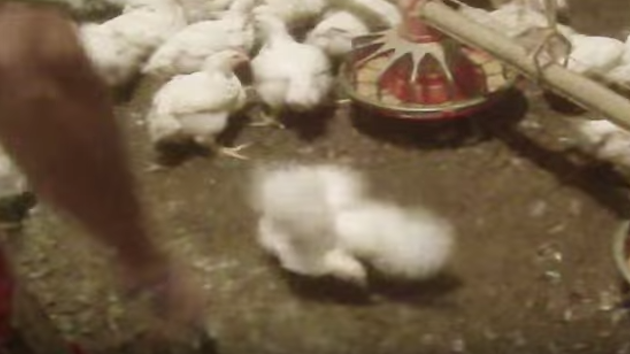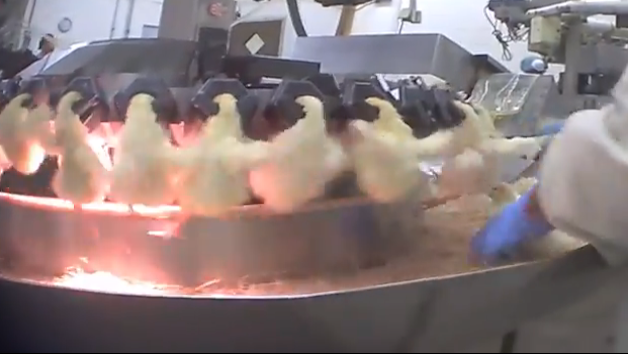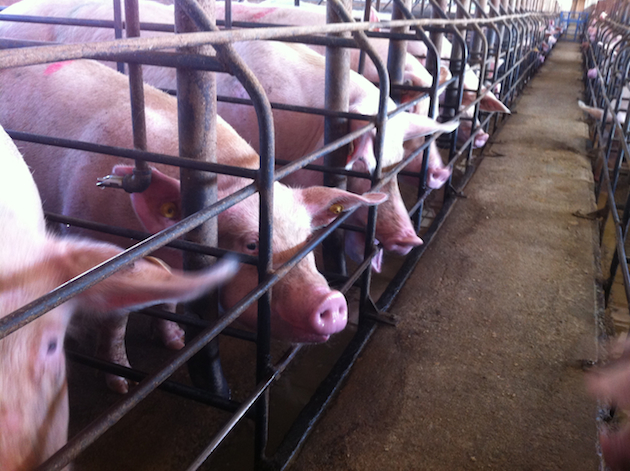Most undercover videos shot behind the meat industry’s closed doors depict conditions in the enclosed barns where animals are birthed and raised. The latest one, taken by an Animal Legal Defense Fund investigator posing as a worker for meat giant Tyson Foods, delivers a glimpse of what it’s like at the other end of the meat-production chain: the slaughterhouse, specifically, Tyson’s chicken plant in Carthage, Texas. Spoiler alert: It’s not pretty.
Granted, the business of systematically killing and processing thousands and thousands of birds in a factory setting is bound to look ugly on film. But this investigator shines a light on something that’s rarely portrayed in these videos: what workers go through. Starting about the 0:35 mark, we get a look at her station: the “live hang department,” where workers snatch live birds and hang them upside down by their feet. Employees are required to hang 35 birds per minute, she reports. In a letter to the Occupational Health and Safety Administration, the ALDF claims that the investigator “wore protective eyewear provided to her by Tyson, but the eyewear failed to prevent the chicken feces, dirt, and chicken dander from getting into her eyes through the sides.” Within weeks, she “developed an infection, and puss discharged from her eyes.”
The investigator claims to have been thrust into the fray without much preparation. “After a two-day orientation covering company policies and health and safety topics, the investigator began hanging chickens,” the ALDF claims in a complaint letter to the US Department of Agriculture, which oversees slaughterhouses. “She was given no training, but was instructed to follow fellow live hang employees.”
Tyson, for its part, disputes that claim. “We don’t believe this claim is true,” a Tyson spokesman wrote in an email to me. “We can tell you employees who work with live animals in the plant must complete chicken animal welfare training and must sign a form acknowledging they have been trained and that they can face possible dismissal if they don’t follow proper animal handling procedures.” As for her claim that she was immediately tasked with a 35-birds-per-minute quota, the Tyson spokesperson claimed that new workers are “allowed to work at their own pace until they become familiar with the job.”
The investigator also raised animal-cruelty and food safety issues based on her experience. She “observed employees mis-hanging birds in their struggle to keep up with the extreme speed of the line, along with employees roughly slamming birds onto shackles on a regular basis,” the ALDF claims in its letter to the USDA. Birds that arrive to the slaughterhouse dead aren’t supposed to enter the food supply, but the investigator “observed dead, dying, and injured birds being hung on slaughter line, suggesting either [the USDA’s] failure to conduct adequate ante-mortem inspection, the plant’s failure to separate live from dead-on-arrival (DOA) birds, or both,” the ALDF’s letter to the USDA states.
Tyson’s reaction: “We’re still reviewing the video, but can tell you we’re absolutely committed to proper animal handling and workplace safety.” The spokesman added, “The safety of our Team Members is very important to us. We continuously monitor our facilities to make sure they’re safe.”
















